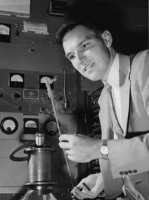










Dr. Dudley Allen Buck who lived between (1927–1959) was an electrical engineer and inventor of components for high-speed computing devices in the 1950s. He is best known for invention of the cryotron, a superconductive computer component that is operated in liquid helium at a temperature near absolute zero.Other inventions were ferroelectric memory, content addressable memory, non-destructive sensing of magnetic fields, and, development of writing printed circuits with a beam of electrons.
Research Career
As a professor at the Massachusetts Institute of Technology, Dr. Buck earned a Doctor of Science from M.I.T. in 1958. Buck began as a research assistant while a graduate student at MIT in 1950. His first assignment was on the I/O systems of the Whirlwind (computer). He was assigned to work with another graduate student, William N. Papian, to work with various manufacturers developing the ferrite materials to be used in Coincident Current Magnetic core memory.
Buck completed his S.M degree in 1952 at MIT. His thesis for the degree was Ferroelectrics for Digital Information Storage and Switching.The thesis was supervised by Arthur R. von Hippel. In this work he demonstrated the principles of storing data in ferroelectric materials; the earliest demonstration of Ferroelectric memory, or FeRAM. This work also demonstrated that ferroelectric materials could be used as voltage controlled switches to address memory,whereas close friend and fellow student Ken Olsen's saturable switch used ferrites and was a current operated switch.
In late 1951 Dudley Buck proposed computer circuits that used neither vacuum tubes, nor the recently invented transistor.It is possible to make all computer logic circuits, including shift registers, counters, and accumulators using only magnetic cores, wire and diodes. Magnetic logic was used in the KW-26 cryptographic communications system, and in the BOGART computer.
By 1957, Buck began to place more emphasis on miniaturization of cryotron systems. The speed that cryotron devices could attain is greater as size of the device is reduced. Dr. Buck, his students, and researcher Kenneth R. Shoulders made great progress manufacturing thin-film cryotron integrated circuits in the laboratory at MIT. Developments included the creation of oxide layers as insulation and for mechanical strength by electron beam reduction of chemicals.This work, co-authored with Kenneth Shoulders, was published as "An Approach to Microminiature Printed Systems". It was presented in December, 1958, at the Eastern Joint Computer Conference in Philadelphia.
Browder J. Thompson Award